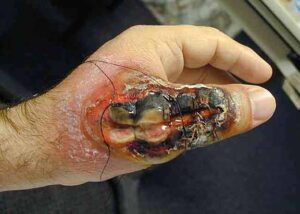One of the things that’s changed a lot from when I first started practicing medicine is people show up every day to the emergency room for mosquito and spider bites. The local news has done a number on you, as now everyone is afraid of MRSA.
Methicillin-resistant Staph Aureus (MRSA) is a bacterial infection that’s resistant to the penicillin family of drugs that we used for decades to treat many infections. Staph Aureus itself is a bacteria akin to flipping a light switch. Normally, it resides within us (approximately 30% of us have it in our nostrils but only 2% of us carry the MRSA variety), not causing any problems, but it is also the source of many dangerous and life-threatening illnesses if it enters your bloodstream.
Over the last 50 years of treating Staph infections, resistance to many different antibiotics has occurred, meaning that when a serious infection occurs, it’s potentially very harmful. The emphasis there should be on potentially. Most MRSA infections are community-acquired skin infections that resemble a spider or other insect bite but are still mild and are treatable with different antibiotics than historically used. Regular Staph and MRSA infections are even more likely to occur in those institutionalized (i.e. in hospitals, nursing homes, etc.) and have tubes and wounds. Consider and discuss the risk with your physician when you see someone on a breathing device, a urinary catheter, needing gauze for surgical wounds or on feeding tubes. Amazingly, MRSA causes approximately 60% of hospital-acquired Staph infections now.
My primary goal today is to inform you of what you need to know to prevent obtaining these infections and when to be especially diligent in seeking treatment. It’s really a simple task of maintaining hygiene. Just prevent that ‘light-switch’ from flipping to the on position and most times you’ll be ok.
1. Staph is everywhere. You can best protect yourself by simply practicing good hygiene. Wash your hands early and often.
2. MRSA is spread by contact. Don’t be so quick to feel and squeeze on someone’s (or your own) boil. Wash your hands before and after such contact. Don’t share towels or razors.
3. Keep any cuts, scratches, nicks or scrapes covered until healed.
If you do see or develop signs of a skin infection (redness, warmth, tenderness, pain and possibly discharge from the wound site), it’s worth contacting your physician to see if s/he’d like to start antibiotics or drain a possible abscess.
So… don’t be afraid, be smart. Prevention is key.
Feel free to ask your SMA expert consultant any questions you may have on this topic.
Take the #72HoursChallenge, and join the community. As a thank you for being a valued subscriber to Straight, No Chaser, we’d like to offer you a complimentary 30-day membership at www.72hourslife.com. Just use the code #NoChaser, and yes, it’s ok if you share!
Order your copy of Dr. Sterling’s new books There are 72 Hours in a Day: Using Efficiency to Better Enjoy Every Part of Your Life and The 72 Hours in a Day Workbook: The Journey to The 72 Hours Life in 72 Days at Amazon or at www.72hourslife.com. Receive introductory pricing with orders!
Thanks for liking and following Straight, No Chaser! This public service provides a sample of what http://www.SterlingMedicalAdvice.com (SMA) and 844-SMA-TALK offers. Please share our page with your friends on WordPress, like us on Facebook @ SterlingMedicalAdvice.com and follow us on Twitter at @asksterlingmd.
Copyright © 2018 · Sterling Initiatives, LLC · Powered by WordPress












